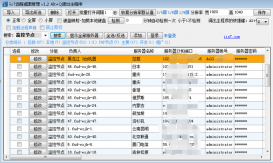直接一行命令搞定:
|
1
2
3
4
5
|
docker run \ --name nginx-health-web-pc \ -d -p 6800:80 \ -v /usr/docker/nginx/html:/usr/share/nginx/html \ nginx |
运行启动不亦乐乎~~~~~这时候忽然前端过来说:“你的nginx里得加一个配置”,顺带还告诉你:“某某某以前就是这样配的",
此时好胜的你当然不能拒绝,但是真正配置起来还是要费点心思的,一般情况下docker启动时进行配置,只要把配置文件的目录挂载出来就可以,简洁方便,但是nginx却是先加载一个主配置文件nginx.conf,在nginx.conf里再加载conf.d目录下的子配置文件(一般最少一个default.conf文件)。这比单独挂载一个目录麻烦了不少,但只要思路清晰,倒也不难。
我们先看挂载好的命令:
启动docker的命令
|
1
2
3
4
5
6
7
|
docker run \ --name myNginx \ -d -p 80:80 \ -v /usr/docker/myNginx/html:/usr/share/nginx/html \ -v /etc/docker/myNginx/nginx.conf:/etc/nginx/nginx.conf:ro \ -v /etc/docker/myNginx/conf.d:/etc/nginx/conf.d \ nginx |
这里有几个注意事项:
(1)第一个“-v”,是项目位置,把项目放到挂载到的目录下即可;
(2)第二个“-v”,是挂载的主配置文件"nginx.conf",注意"nginx.conf"文件内有一行"include /etc/nginx/conf.d/*.conf;",这个include指向了子配置文件的路径,此处注意include后所跟的路径一定不要出错。
(3)第三个“-v”,把docker内子配置文件的路径也挂载了出来,注意要与(2)中include指向路径一致
(4)重点强调一下,nginx.conf是挂载了一个文件(docker是不推荐这样用的),conf.d挂载的是一个目录
我们先启动一下,可以发现是有问题的,因为配置文件还没有。
配置配置文件
我们找到常规方法安装的nginx时生成的配置文件(一般以“/etc/nginx”下),对应上面启动命令中的挂载位置,把主配置文件nginx.conf放到对应位置“/etc/docker/myNginx/nginx.conf”,把子配置文件“default.conf”放到“/etc/docker/myNginx/conf.d”目录下
重新运行启动命令,发现已经好了,至此docker中的文件已经可以随意配置,跟原生安装是一模一样的
思路:配置时一定要铆定一个思路:挂载出来的文件运行时是要加载到docker进程中去的!这样就不容易混淆。
---------------------------------------------------分隔线-------------------------------------------------------
贴出我的配置文件:
nginx.conf
|
1
2
3
4
5
6
7
8
9
10
11
12
13
14
15
16
17
18
19
20
21
22
23
24
25
26
27
28
29
30
31
32
33
34
35
36
|
user root;worker_processes 1; error_log /var/log/nginx/error.log warn;pid /var/run/nginx.pid; events { worker_connections 1024;} http { include /etc/nginx/mime.types; default_type application/octet-stream; log_format main '$remote_addr - $remote_user [$time_local] "$request" ' '$status $body_bytes_sent "$http_referer" ' '"$http_user_agent" "$http_x_forwarded_for"'; access_log /var/log/nginx/access.log main; sendfile on; #tcp_nopush on; keepalive_timeout 65; autoindex on; #gzip on; include /etc/nginx/conf.d/*.conf; client_max_body_size 100M; client_header_buffer_size 128k; large_client_header_buffers 4 128k;} |
default.conf
|
1
2
3
4
5
6
7
8
9
10
11
12
13
14
15
16
17
18
19
20
21
22
23
24
25
26
27
28
29
30
31
32
33
34
35
36
37
38
39
40
41
42
43
44
45
46
47
48
|
server { listen 80; server_name localhost; #charset koi8-r; #access_log /var/log/nginx/log/host.access.log main; location / { root /usr/nginx/dacheng-wechat-web; # root /usr/nginx/html; index index.html index.htm; autoindex on; try_files $uri /index/index/page.html; #try_files $uri /index/map/page.html; } #error_page 404 /404.html; # redirect server error pages to the static page /50x.html # error_page 500 502 503 504 /50x.html; location = /50x.html { root /usr/share/nginx/html; } # proxy the PHP scripts to Apache listening on 127.0.0.1:80 # #location ~ \.php$ { # proxy_pass http://127.0.0.1; #} # pass the PHP scripts to FastCGI server listening on 127.0.0.1:9000 # #location ~ \.php$ { # root html; # fastcgi_pass 127.0.0.1:9000; # fastcgi_index index.php; # fastcgi_param SCRIPT_FILENAME /scripts$fastcgi_script_name; # include fastcgi_params; #} # deny access to .htaccess files, if Apache's document root # concurs with nginx's one # #location ~ /\.ht { # deny all; #}} |
以上就是本文的全部内容,希望对大家的学习有所帮助,也希望大家多多支持服务器之家。
原文链接:https://blog.csdn.net/wangfei0904306/article/details/77623400


















